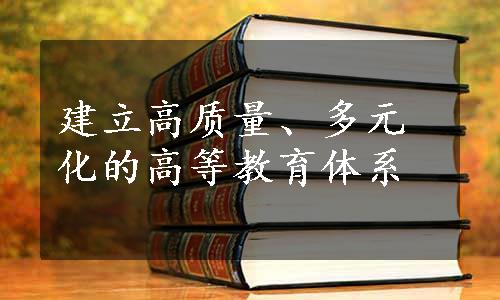
建立高质量、多元化的高等教育体系
各位尊贵的来宾,女士们、先生们:
今天非常荣幸代表新加坡来参加“东亚峰会高等教育合作论坛”,这次论坛致力于加强教育方面的合作和交流,在“10+6”的框架中实现这些工作。我们在高等教育方面已经实现了快速的国际化的趋势,而且在这个领域,亚洲已经发挥了越来越重要的作用。
我们今天早上听了王立英女士和凯瑟琳·坎贝尔的建议,我们新加坡致力于一个建立高质量、多元化的机构体系,我们希望在这个国际化方面发挥更重要的作用,我们的优势就是在于我们的人的质量、人的素质。为了维持我们新加坡的竞争力,我们要有全球最高质量的机构,我们要实现这个目标,新加坡有30所这样的大学,如新加坡管理大学等。这些大学在这方面都有很好的建树,它们是我们这个区域最好的大学。它们培养了高质量的毕业生,能够满足我们的经济和不断前进的研究和创造方面的要求。
随着经济的发展,我们的大学方面会进行不断的拓展,它不仅可以提高我们的毕业生的数量,也使我们的毕业生具有必要的素质,在非常复杂的社会中能够生存。我们现在要建立一所新加坡新大学,它是由麻省理工学院集中办学的新大学。另外,我们还有与南洋理工大学、南洋大学和耶鲁大学共同建立了一个人文学院。所有的这些新学院,都会有一个独特的教育模型,而且它会为新加坡的高等教育注入新的活力。新加坡的技术设计学院主攻方向是高级的研究性的教学,它比较关注建筑行业和工程学。这方面有跨学科的课程,东西贯通,它非常强调创业精神和创新精神。人文学院也是第一个这样的学院。
另外,我们新的医学院,它会满足新加坡的健康医疗方面不断增长的需求,充分发掘伦敦皇家帝国学院的这些优势,充分发挥教学的成绩或者资源。除此之外,新加坡也建立了的技术学院,满足技校学生的需求。
我们与英国的曼彻斯特大学、美国的拉斯维加斯大学协作,我们的技术学院是两年的学制,可以减少求学的成本,也不会以牺牲质量为代价。这些新的学院,表明了我们的国际化趋势,我们将在这个领域发挥更大的作用。与英国的皇家学院的协作,就使我们能够充分地利用我们成功的模式与经验,不断地去挖掘潜在的商业市场,以及知识市场和治理市场的资源。
我们的RHR,就是高等学院,在“10+6”的框架中有很多的合作。与高丽大学、耶鲁大学等都有非常好的合作,它们在上海、首尔、新加坡有这样的机制。南洋理工大学与印度学院有科研与学生的交流活动,现在向印度学院提供一个MBA的学位。与澳大利亚也签了一个谅解备忘录,提高我们的教学质量,使我们的教学系统更加丰富,提高它们国际化的水平。
在这方面,我们要不断地加以改进,在我们的这个区域内,不断地扩展这方面的工作。中国和印度最终到2020年,能够达到1400万的毕业人数。大家可以看这个规模很大,亚洲的人才总数也很多,他们是能够从我们所提供的高等教育方面的理念中获益的。
最后,我希望向中国的教育部、云南省人民政府表达衷心的感谢!同时,也感谢昆明市的朋友们,感谢你们的盛情款待!我坚信,我们一定能够不断地促进东亚这方面的工作。
谢谢各位!
附一:新加坡教育部高等教育司副司长林国伟先生发言稿英文
Speech at the East Asia Summit Higher Education Cooepration Forum
Mr.Peter LamKok Wai
Deputy Director(higher Education),Ministry of Education,Sigapore
(October 13-15,2010 Kunming,Yunnan,China)
Mr.Luo Chongmin,Director,Yunnan Provincial Department of Education,
Distinguished Delegates,
Ladies and Gentlemen,
I amhonoured to represent Singapore today at the inaugural East Asia Higher Education Cooperation Forum.This forum,which seeks to enhance educational cooperation and exchanges under the 10+6 framework,[1]is timely given the rapid internationalisation of the tertiary sector and Asia's emergence as a major player in the global higher education landscape.(www.xing528.com)
Thismorning,we have heard excellent speeches fromspeakers like MadamWang Liyin and Ms Kathryn Campbell who painted global challenges and opportunities and the need formore enhanced collaboration among governments and tertiary institutions on higher education to respond to these challenges.
To contribute to today's discussion,I would like to share with youSingapore's efforts to build a high quality,diversified tertiary sector,and the important role which internationalisation plays in helping us to achieve this.
Developing a high quality tertiary sector
Singapore is a small country.Our strength lies in the quality of our people.To maintain our competitive edge and prosper as a country we need to ensure thatwe have top-class educational institutions which provide our students with a high quality education.To this end,Singapore's three universities–National University of Singapore(NUS),Nanyang Technological University(NTU)and Singapore Management University–have done well.They are among the best universities in the region and have contributed significantly to Singapore's development by producing high quality graduate manpower to meet the needs our economy,advancing research and creating knowledge.
As our economy develops,we will expand our university sector by establishing new institutions which will not only increase our graduate manpower,but equip our graduates with the different skills necessary to navigate an increasingly complex global environment.These include a new university,the Singapore University of Technology&Design(SUTD)that is established in collaboration with MIT and Zhejiang University,a newmedical school jointly developed by NTUand Imperial College London,and a possible tie-up between NUS and Yale University to establish a liberal arts college in Singapore.
Each of these new institutionswill be distinguished by a unique educational model and will add diversity to Singapore's higher education landscape. SUTD is positioned as a top-tier research-intensive university with an initial focus on Engineering and Architecture.Itwill offer a novelmulti-disciplinary curriculumwhich blends the best of both east and west,with entrepreneurship and innovation as hallmarks of its brand of education.The liberal arts college,a first in Asia,will provide an education model to develop leaders of industry,academia and nations.Finally,the newmedical schoolwill notonly provide for Singapore's healthcare needs but also seeks to tap on Imperial College's experience and NTU's capabilities to interface engineering and medicine to innovate better medical systems and devices for health care.
In addition,Singapore also recently set up the Singapore Institute of Technology(SIT)to cater to polytechnic upgraders.This institution is founded on the basis of collaboration.The SIT will partner reputable overseas universities to offer degrees to polytechnic graduates in the name of those universities.Partner universities include UK's Newcastle University and Manchester University,TUM,and University of Nevada Las Vegas.Polytechnic graduates can obtain these degrees in two years.This will save costs,without diluting any quality.
Importance of Internationalisation
These new institutions reflect the importance of internationalisation to the development of our tertiary sector and Asia's rising importance in the global higher education landscape.Our deep educational collaborations with MIT,Zhejiang University,Yale and Imperial College for example,allow us to draw references fromsuccessful educationalmodels around the world which we then adapt and contextualise to Asia to tap on its emerging intellectual and commercialmarkets.
At present,our institutes of higher learning(IHLs)have extensive collaborations with IHLs within the 10+6 framework of nations.For instance,NUS together with China's Fudan University and Korea University,has established the Shanghai,Seoul and Singapore University Alliance to offer business programmes focused on Asia.NTU has collaborated with the Indian Institute of Technology(IIT)Kanpur on student exchanges and joint research,and cur-rently offers a double MBA degree together with Japan's Waseda University. SMUhas also signed a Memorandumof Understanding(MOU)with the University ofWestern Australia(UWA)to collaborate in sports and adventure education.These overseas collaborations not only add to the quality and variety of our educational programmes but also enhance our students'experience through the international exposure which they offer.
However,there ismore scope to enhance educational collaboration within the 10+6 framework as the Asian higher education sector expands.With China and India expected to produce a combined 14 million graduates by 2020,there will be a surge of talentwithin Asia which will benefit fromthe exchange of ideas and diverse educational experiences offered by enhanced educational collaboration.
Conclusion
To conclude,I would like to express my appreciation to the Ministry of Education(China),Government of Yunnan Province,and people of Kunming City for your warmhospitality.
I look forward to a fruitful discussion at this forumand trust itwill add valuable insights and share ideas on ways to enhance educational cooperation in East Asia.
Thank you.
附件二:新加坡教育部高等教育司副司长林国伟先生简历
新加坡教育部高等教育司副司长林国伟先生戎马出身,上校军衔、步兵营副指挥官。曾任新加坡义安理工学院计划与项目主任,现任新加坡教育部高等教育司副司长。林国伟先生是新加坡公共服务委员会留学奖学金的获得者,以优异的成绩毕业于伦敦帝国理工学院,获硕士学位。曾进修过欧洲工商学院青年管理者课程。
【注释】
[1]The 10+6 framework comprises of the 10 ASEANnations and the other6 nations of China,India,Korea,Japan,NewZealand and Australia.
免责声明:以上内容源自网络,版权归原作者所有,如有侵犯您的原创版权请告知,我们将尽快删除相关内容。




